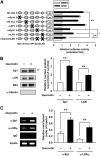Quercetin enhances ABCA1 expression and cholesterol efflux through a p38-dependent pathway in macrophages
- PMID: 22711909
- PMCID: PMC3413225
- DOI: 10.1194/jlr.M024471
Quercetin enhances ABCA1 expression and cholesterol efflux through a p38-dependent pathway in macrophages
Abstract
ATP-binding cassette transporter A1 (ABCA1) plays a crucial role in exporting cholesterol from macrophages, a function relevant to its involvement in the prevention of atherosclerosis. Quercetin, one of flavonoids, has been described to reduce atherosclerotic lesion formation. This study is aimed to investigate the effect of quercetin on regulation of ABCA1 expression and to explore its underlying mechanisms in macrophages. The results show that quercetin markedly enhanced cholesterol efflux from macrophages in a concentration-dependent manner, which was associated with an increase in ABCA1 mRNA and protein expression. Remarkably, quercetin is able to stimulate the phosphorylation of p38 by up to 234-fold at 6 h via an activation of the transforming growth factor β-activated kinase 1 (TAK1) and mitogen-activated kinase kinase 3/6 (MKK3/6). Inhibition of p38 with a pharmacological inhibitor or small hairpin RNA (shRNA) suppressed the stimulatory effects of quercetin on ABCA1 expression and cholesterol efflux. Moreover, knockdown of p38 reduced quercetin-enhanced ABCA1 promoter activity and the binding of specificity protein 1 (Sp1) and liver X receptor α (LXRα) to the ABCA1 promoter using chromatin immunoprecipitation assays. These findings provide evidence that p38 signaling is essential for the regulation of quercetin-induced ABCA1 expression and cholesterol efflux in macrophages.
Figures







Similar articles
-
Quercetin up-regulates expressions of peroxisome proliferator-activated receptor γ, liver X receptor α, and ATP binding cassette transporter A1 genes and increases cholesterol efflux in human macrophage cell line.Nutr Res. 2013 Feb;33(2):136-43. doi: 10.1016/j.nutres.2012.11.010. Epub 2012 Dec 27. Nutr Res. 2013. PMID: 23399664
-
Inhibition of ERK1/2 and activation of liver X receptor synergistically induce macrophage ABCA1 expression and cholesterol efflux.J Biol Chem. 2010 Feb 26;285(9):6316-26. doi: 10.1074/jbc.M109.073601. Epub 2009 Dec 25. J Biol Chem. 2010. PMID: 20037141 Free PMC article.
-
Transcriptional regulation of ATP-binding cassette transporter A1 expression by a novel signaling pathway.J Biol Chem. 2011 Mar 18;286(11):8917-23. doi: 10.1074/jbc.M110.214429. Epub 2011 Jan 21. J Biol Chem. 2011. PMID: 21257755 Free PMC article.
-
Potential Therapeutic Agents That Target ATP Binding Cassette A1 (ABCA1) Gene Expression.Drugs. 2022 Jul;82(10):1055-1075. doi: 10.1007/s40265-022-01743-x. Epub 2022 Jul 21. Drugs. 2022. PMID: 35861923 Review.
-
History and Development of ABCA1.Curr Probl Cardiol. 2024 Jan;49(1 Pt A):102036. doi: 10.1016/j.cpcardiol.2023.102036. Epub 2023 Aug 17. Curr Probl Cardiol. 2024. PMID: 37595859 Review.
Cited by
-
Sparstolonin B suppresses rat vascular smooth muscle cell proliferation, migration, inflammatory response and lipid accumulation.Vascul Pharmacol. 2015 Apr-Jun;67-69:59-66. doi: 10.1016/j.vph.2015.03.015. Epub 2015 Apr 11. Vascul Pharmacol. 2015. PMID: 25869499 Free PMC article.
-
Roles of ABCA1 in cancer.Oncol Lett. 2022 Aug 19;24(4):349. doi: 10.3892/ol.2022.13469. eCollection 2022 Oct. Oncol Lett. 2022. PMID: 36072007 Free PMC article. Review.
-
Effects of Quercetin Nanoemulsion on Cholesterol Efflux and MicroRNA-33/34a Expression in the Liver of Mice Fed with a High-Cholesterol Diet.Prev Nutr Food Sci. 2023 Sep 30;28(3):271-277. doi: 10.3746/pnf.2023.28.3.271. Prev Nutr Food Sci. 2023. PMID: 37842255 Free PMC article.
-
Modulation of microRNA Expression in Subjects with Metabolic Syndrome and Decrease of Cholesterol Efflux from Macrophages via microRNA-33-Mediated Attenuation of ATP-Binding Cassette Transporter A1 Expression by Statins.PLoS One. 2016 May 3;11(5):e0154672. doi: 10.1371/journal.pone.0154672. eCollection 2016. PLoS One. 2016. PMID: 27139226 Free PMC article.
-
Phloretin suppresses neuroinflammation by autophagy-mediated Nrf2 activation in macrophages.J Neuroinflammation. 2021 Jul 4;18(1):148. doi: 10.1186/s12974-021-02194-z. J Neuroinflammation. 2021. PMID: 34218792 Free PMC article.
References
-
- Peluso M. R. 2006. Flavonoids attenuate cardiovascular disease, inhibit phosphodiesterase, and modulate lipid homeostasis in adipose tissue and liver. Exp. Biol. Med. (Maywood). 231: 1287–1299. - PubMed
-
- Boots A. W., Haenen G. R., Bast A. 2008. Health effects of quercetin: from antioxidant to nutraceutical. Eur. J. Pharmacol. 585: 325–337. - PubMed
-
- Bischoff S. C. 2008. Quercetin: potentials in the prevention and therapy of disease. Curr. Opin. Clin. Nutr. Metab. Care. 11: 733–740. - PubMed
-
- Kleemann R., Verschuren L., Morrison M., Zadelaar S., van Erk M. J., Wielinga P. Y., Kooistra T. 2011. Anti-inflammatory, anti-proliferative and anti-atherosclerotic effects of quercetin in human in vitro and in vivo models. Atherosclerosis. 218: 44–52. - PubMed
-
- Rivera L., Moron R., Sanchez M., Zarzuelo A., Galisteo M. 2008. Quercetin ameliorates metabolic syndrome and improves the inflammatory status in obese Zucker rats. Obesity (Silver Spring). 16: 2081–2087. - PubMed
Publication types
MeSH terms
Substances
LinkOut - more resources
Full Text Sources
Medical
Research Materials
Miscellaneous

